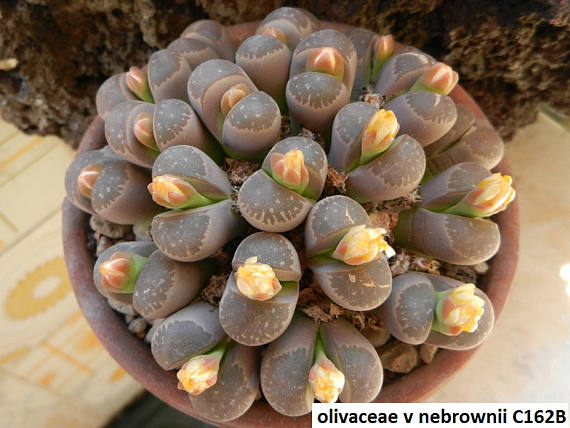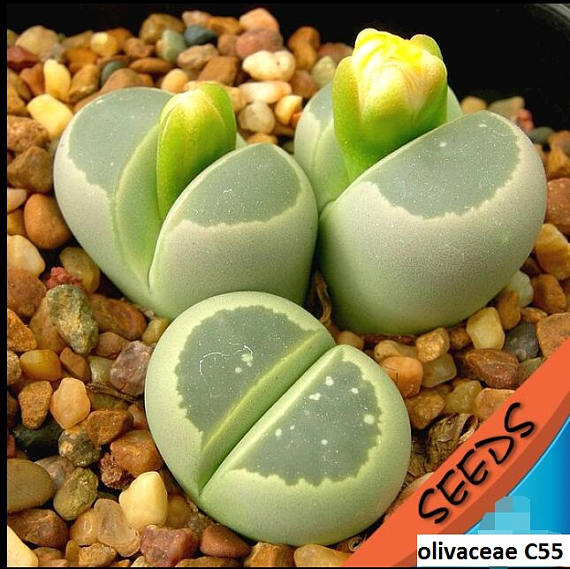Lithops olivacea (3 subspecies) - 20 seeds





Lithops olivacea (3 subspecies) - 20 seeds
Rare - Lithops species are probably amongst the most well-camouflaged and cryptic plants in the world. Their common name, stone plant, is particularly apt, as they are often extremely difficult to spot when they are growing nested amongst the gravel in their natural habitat. They are bizarre little plants that have a strange but fascinating beauty in their coloration and form that captures the attention of anyone who stumbles across them. Their ease of growth makes them popular pot plants and, if well-cared for, will make lifelong companions.
1. Sterilize substrate (3+ minutes in microwave or 50 mins in oven- (350°F) and let it cool)
2. Mesembs (Lithops, Conophytums...) require a well draining soil, which means it dries out quickly. Soil should contain a lot of pumice, perlite or sand. Sand should consist of many sizes of particles, from dust to 1/8”. The basic soil mix is 1 soil mix to 3 pumice and sand. Remove any big chunks (peat) from the potting soil.
3. Planters should be about 1-1.5 inches deep. Fill a container with good draining soil. Leave 1/2 inches to the top free. Press the substrate, equally.
4. Disperse pebbles granulated up to 0.2 inches
5. You can sow 50 -100 seeds into one planter 3x3 inches. Mesemb seeds are very tiny.
6. Equally Water the substrate with water (boil and then let it cool) - place a piece of a napkin on top of the substrate and slowly pour the water over it.
7. Let the container soak up water for 5 minutes. Leave the container to drain out the water surplus.
8. Mix some fine sand to the bag with seeds, and sprinkle contents of the bag onto the substrate and pebbles. Do not cover with too much soil or the seeds may not germinate.
9. Put the whole container into a zip bag to keep humidity.
10. Avoid exposing to direct sunlight, but provide them light on some bright place, temperature should be about 77°F.
11. The germination process usually starts within 4-7 days but some seeds can germinate after month or two. Don't expect all the seed to germinate at the same time.
12. Start opening the container gradually so that the seedlings can get used to the new air conditions. Remove bag completely after a month.
13. Seedlings need some moisture, substrate shouldn’t be dry, but don’t overwater. and they need an ample amount of light – but not direct sunlight! you need to take care of them constantly next 3-5 months.
14. Repot them when you notice that seedlings are space-limited, which is usually in a year.
15. Buy only seeds from reputable sources like www.rareplant.me. That way you will avoid scams, fake or bad seeds, and you will always get fresh ones.
Lithops plants, contrary to popular belief, are easy to grow. The small seeds can be sown in pots of fine, well-drained sand, any time during the summer months when temperatures are warm. Cover the seeds with a very fine layer of grit and water from below with a fungicide to prevent damping off. For the first 3-4 days cover the pots with a sheet of glass/clear perspex to keep the humidity levels high. Remove the glass and replace it with light shadecloth and mist once or twice a day for the next two weeks after which most seeds should have germinated. From then on mistings can be reduced to every second and then every third day as the little plants grow. At this stage it is not a good idea to flood the pot as this encourages lithops soup!
When the plants are a year old, water them once every two weeks in summer and once every 2 months (if necessary) in winter. When the new leaves are pushing though the old leaves, watering should be stopped altogether otherwise leaf pairs start stacking on top of each other. They need a bright spot to grow — somewhere that gets at least half a day of direct sunlight, otherwise they elongate and become ugly. Mealy bug is their worst enemy; if the 'white fluff' is found between the leaves, spray with an insecticide that has either chlorpyrifos or imidacloprid as an active ingredient. They do not need any fertilizer, but a weak solution from time to time won't do them any harm. If well-loved and cared for they make lovely and fascinating pot plants.
